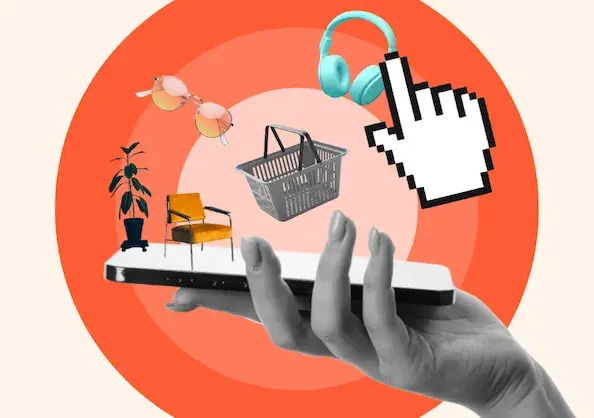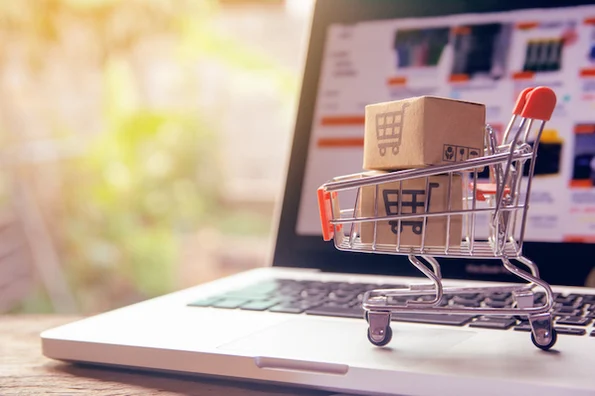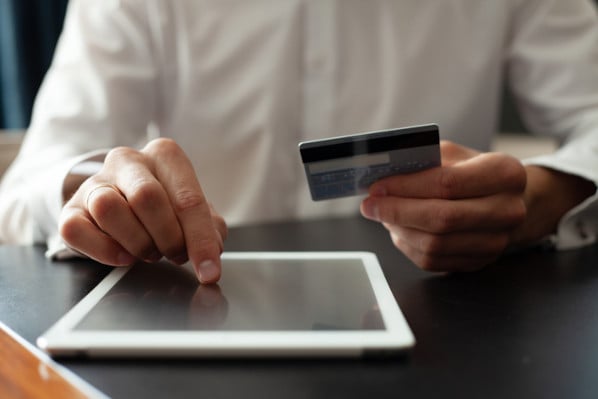Below I’ve compiled a list of ecommerce statistics that will help you understand the potential impact of using the practice, as well as its growth potential throughout 2024 and beyond.
Table of Contents
- General Ecommerce Statistics
- Social Media Ecommerce Statistics
- Ecommerce Growth Statistics
- Consumer Behavior and Demographics Ecommerce Statistics
- B2B Ecommerce Statistics
- B2C Ecommerce Statistics
- Mobile Ecommerce Statistics
General Ecommerce Statistics
-
The average number of products bought per online order is 4.95. (Statista, 2023)
-
The global conversion rate of online shoppers is 1.9%. (Statista, 2023)
-
High-performing retail businesses are more likely to invest a given amount of their sales in digital and ecommerce. (Boston Consulting Group, 2023)
-
A majority of social media marketers (68%) use social media to drive traffic to products on its own website. (HubSpot, 2024)
-
eMarketer predicts that Grocery will become the largest ecommerce category in the U.S. by 2026. (eMarketer, 2024)

Image Source -
There was a 20% increase in consumers shifting to ecommerce channels in 2020. (McKinsey, 2023)The average cart abandonment rate is 70.19%. (Baymard, 2023)
-
Amazon is the biggest e-commerce company worldwide with a 1.34 trillion USD market cap. (Statista, 2023)
-
Free delivery is the main reason 45% of shoppers head online. (Data Reportal, 2023)
-
Most marketers say they have an employee responsible for managing social commerce. (HubSpot, 2024)
Social Media Ecommerce Statistics
-
87% of sellers say social selling has been effective for their business this year. (HubSpot, 2023)
-
59% of social sellers say their company is making more sales through social media this year than last year. (HubSpot, 2023)

Image Source -
High performing salespeople are 12% more likely to use social media when selling. (HubSpot, 2024)
-
More than half of social media marketers use social media to sell products directly within social media apps. (HubSpot, 2024)
-
50% of marketers plan to increase their investment in selling products directly in social media apps in 2024. (HubSpot, 2024)
-
Facebook, Instagram, and YouTube are the platforms social media marketers most commonly use for social selling. (HubSpot, 2024)
-
Instagram, TikTok, and Facebook offer the highest ROI for social selling. (HubSpot, 2024)
-
Social media is 3rd place in terms of channels where consumers are most receptive to advertising. (Integral Ad Science, 2024)
-
Social media marketers who sell products directly through social media apps say Facebook and YouTube have the highest ROI. (HubSpot, 2024)
Ecommerce Growth Statistics
-
Retail ecommerce sales are projected to reach more than eight trillion dollars by 2027. (Statista, 2023)
-
84% of social media marketers predict that, in 2024, consumers will buy products from brands directly in social media apps more than third-party websites and brand websites. (HubSpot, 2024)
-
Gartner predicts that 80% of B2B sales interactions will occur on digital channels by 2025. (Gartner, 2020)
-
eMarketer predicts that global retail media ad spend will reach $140 billion this year, which makes up 20.3% of all digital ad spend. (eMarketer, 2023)
-
The revenue in the US ecommerce market is forecasted to increase by 475 billion USD between 2024 and 2028. (Statista, 2023)
Consumer Behavior and Demographic Ecommerce Statistics
-
19% of consumers have reached out to customer service via DMs in the past 3 months, up 45% from 2022. (HubSpot, 2023)

Image Source -
A majority of consumers (82%) say they’re satisfied with their most recent social shopping experience. (HubSpot, 2023)
-
Adults aged 18 to 24 make up the largest share of ecommerce shoppers in the U.S. (Statista, 2023)
-
China has the highest number of consumers shopping on social networks. (Statista, 2023)
-
The total revenue of online retail in Asian countries totaled 1.7 trillion USD in 2023. (Statista, 2023)
-
The most common reason for cart abandonment among consumers is extra costs for things like shipping and taxes. Needing to create an account is the 2nd. (Forbes, 2023)
-
Gen Z, Millennials, and Gen X prefer finding products on social media over any other channel. (HubSpot, 2023)
 Image Source
Image Source -
Just 47% of social media users feel comfortable buying through social media apps. (HubSpot, 2023)
-
42% of consumers trust social media platforms with their personal card information. (HubSpot, 2023)
-
Facebook wins among social media users when it comes to social media shopping. It’s the most popular app for in-app purchases, they say it offers the best in-app shopping experience, and it’s the most trusted. (HubSpot, 2023)
-
TikTok is the least trusted platform among consumers for in-app shopping. (HubSpot, 2023)
-
A majority of consumers only somewhat agree that the products they buy directly on social media will come as described/depicted. (HubSpot, 2023)
-
The main concern consumers have about buying products directly within social media platforms is that the sellers aren’t legitimate companies/are a scam. (HubSpot, 2023)
B2B Ecommerce Statistics
-
79% of B2B buyers say they prefer to place repeat orders online. (Sana Commerce, 2023)
-
The main hurdle B2B buyers face with online purchasing is lack of accurate information on delivery times. (Sana Commerce, 2023)
-
65% of B2B companies across all industries offer ecommerce capabilities. (McKinsey, 2023)
-
80% of B2B companies say they hold their ecommerce channel to the same or higher standard as other channels. (McKinsey, 2023)
-
More than 1/3 of B2B buyers say they’re willing to spend $500,000 or more on digital channels, and 15% say they’re comfortable making purchases of more than $1 million online. (McKinsey, 2023)
B2C Ecommerce Statistics
-
Global B2C ecommerce revenue is projected to grow to 5.5 trillion USD by 2027. (International Trade Administration, 2024)
-
The most popular B2C e-commerce segments are consumer electronics, fashion, and furniture. (International Trade Administration, 2024)
Mobile Ecommerce Statistics
-
Smartphones account for 66% of online orders. (Statista, 2023)
-
Mobile retail e-commerce sales in the U.S. are expected to reach more than 560 billion by the end of 2024. (Statista, 2023)
-
Mobile Retail ecommerce sales in the U.S. will exceed 450 billion USD by the end of 2024. (Statista, 2024)
-
Apple Pay is the most used mobile payment format among U.S. consumers. (Statista, 2023)
-
60% of US adults believe that mobile shopping is a necessity for online shopping convenience. (eMarketer, 2022)
-
80% of consumers worldwide visit a retailer’s website from their smartphone while shopping in-store. (eMarketer, 2023)
-
Business Insider predicts that mobile commerce will account for 42.9% of e-commerce sales in 2024. (Business Insider, 2022)
Ecommerce




.png)






![Starting an Ecommerce Biz? Here are 12 Steps to Get Started [+ Best Practices]](https://53.fs1.hubspotusercontent-na1.net/hubfs/53/ecommerce_1.webp)
